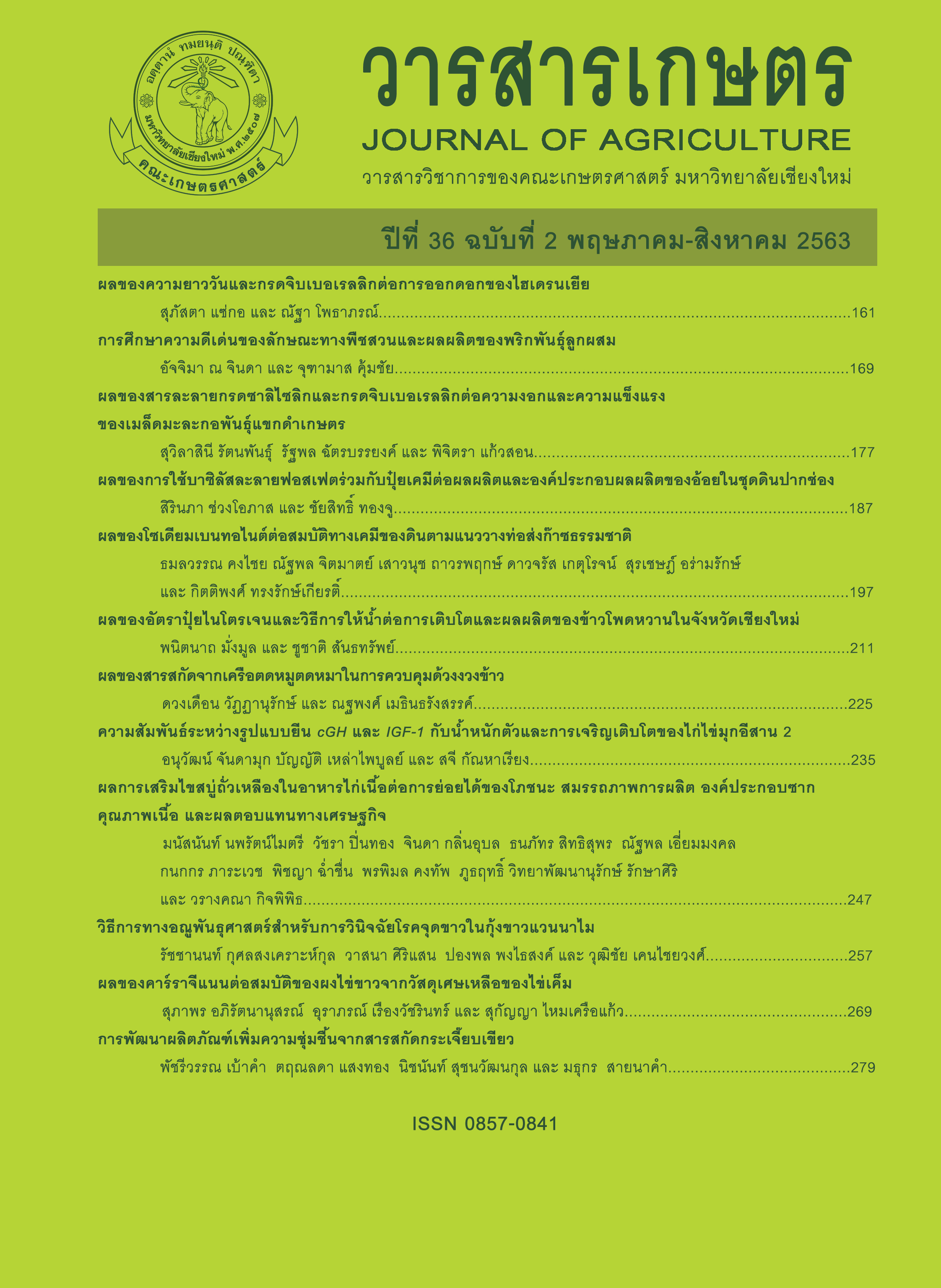ผลของสารสกัดจากเครือตดหมูตดหมาในการควบคุมด้วงงวงข้าว
Main Article Content
บทคัดย่อ
ปัญหาในการเก็บรักษาข้าวคือการติดต่อและการเข้าทำลายของแมลงศัตรูข้าว โดยเฉพาะอย่างยิ่งด้วงงวงข้าวเป็นหนึ่งในแมลงศัตรูหลักของข้าวสารในประเทศไทย วัตถุประสงค์คือเพื่อศึกษาผลของสารสกัดจากเครือตดหมูตดหมาในการเป็นสารไล่ สารฆ่าและสารยับยั้งการออกลูกหลานของด้วงงวงข้าว ที่ระดับความเข้มข้น 0, 0.25, 0.5, 1.0, 2.0, 4.0 และ 8.0% (w/v) วางแผนการทดลองแบบสุ่มสมบูรณ์ (completely randomized design; CRD) ความเข้มข้นละ 5 ซ้ำ ซ้ำละ 10 ตัว ทำการทดลองที่ห้องปฏิบัติการชีววิทยา ผลการทดลองพบว่าผลสารสกัดจากเครือตดหมูตดหมามีผลต่อการไล่ การฆ่า และการยับยั้งการออกลูกหลานของด้วงงวงข้าวได้มีความแตกต่างกันอย่างมีนัยสำคัญที่ระดับความเชื่อมั่น 95% เมื่อเปรียบเทียบกับชุดควบคุม ที่ความเข้มข้น 8% มีประสิทธิภาพในการเป็นสารไล่ สารฆ่า และสารยับยั้งการออกลูกหลานของด้วงงวงข้าวสูงสุด โดยมีผลต่อการไล่ด้วงงวงข้าวเฉลี่ย 9.60 + 0.48 ตัว คิดเป็นเปอร์เซ็นต์การไล่ 92% ที่เวลา 12 ชั่วโมง และมีผลต่อการไล่ด้วงงวงข้าวสูงสุดเฉลี่ย 10.00 + 0.00 ตัว คิดเป็นเปอร์เซ็นต์การไล่ 100% เวลา 24 ชั่วโมง มีอัตราการตายของด้วงงวงข้าวสูงสุด 100% ค่า LC50 มีค่าเท่ากับ 1.62 และ 0.89% ในชั่วโมงที่ 24 และ 48 ชั่วโมง ตามลำดับ ในการเป็นสารยับยั้งการเจริญเติบโต มีจำนวนตัวเต็มวัยที่ฟักออกมาเท่ากับ 0.40 + 0.48 ตัว คิดเป็นเปอร์เซ็นต์การยับยั้งการออกลูกหลาน 98.84% ใช้ระยะเวลาในการเจริญเติบโตเท่ากับ 52.20 + 1.72 วัน เมื่อเปรียบเทียบกับชุดควบคุมมีจำนวนตัวเต็มวัยที่ฟักออกมาเท่ากับ 34.60 + 3.55 ตัว คิดเป็นเปอร์เซ็นต์การยับยั้งการออกลูกหลาน 0.0% ใช้ระยะเวลาในการเจริญเติบโตเท่ากับ 29.60 + 0.74 วัน
Article Details
เอกสารอ้างอิง
Abbott, W.S. 1925. A method for computing the effectiveness of an insecticide. Journal of Economic Entomology 18(2): 265-267.
Adeyemi, M.M.H. 2011. The potential of secondary metabolites in plant material as deterents against insect pests: A review. African Journal of Pure and Applied Chemistry 4(11): 243-246.
Ali, S.A.I., M.M. Diakite, S. Ali and M.Q. Wang. 2015. Understanding insect behaviors and olfactory signal transduction. Enliven: Journal of Genetic, Molecular and Cellular Biology 2(2): 004, doi: 10.18650/2379-5700.22004.
Aulicky, R. and V. Stejskal. 2015. Efficacy and limitations of phosphine “spot-fumigation” against five Coleoptera species of stored product pests in wheat in a grain store – short note. Plant Protection Science 51(1): 33-38.
Azad, M.A.K., M.N. Yesmin and M.S. Islam. 2012. Effect of botanical extract on pest control in brinjal field. Journal of Environmental Science and Natural Resources 5(2): 173-176.
Chaiyarat, A. 2017. Fever vine, grass and medicine. (Online). Available: https://www.technologychaoban.com/ folkways/article_10025 (December 1, 2018). (in Thai)
Colin, A.C., J.A. Chalfant, R.E. Goodhue, F.M. Han and M. DeSantis. 2005. The methyl bromide ban: economic impacts on the California strawberry industry. Review of Agricultural Economics 27(2): 181-197.
Finney, D.J. 1971. Probit Analysis. 3rd ed. Cambridge University Press, London.
Flay, C.D. 2010. Multiple mating and mate choice in Sitophilus oryzae (L.) (Coleoptera: Curculionidae. M.S. Thesis. Massey University, Palmerston North, New Zealand. 83 p.
Hamza, A.F., M.N. El-Orabi, O.H. Gharieb, A.H.A. El-Saeady and A.R.E. Hussein. 2016. Response of Sitophilus granarius L. to fumigant toxicity of some plant volatile oils. Journal of Radiation Research and Applied Sciences 9(1): 8-14.
Hussein, A.E., H. Abd Elhaseeb, R.A. Mohamed, M. Abdel-Mogib and Z. Abou Elnaga. 2017. Toxicity of three chemical extracts of black pepper fruits against two stored grain insect pests. International Journal of Pharmaceutical Science Invention 6(10): 20-29.
Kamara, J.S., S.M. Kanteh, S.M. Bockari-Gevao and S. Jalloh. 2014. Infestation, population density and sterilization effects on rice weevils (Sitophilus oryzae L.) in stored milled rice grains in Sierra Leone. International Journal of Agriculture and Forestry 4(1): 19-23.
Nguyen, T.T., P.J. Collins and P.R. Ebert. 2015. Inheritance and characterization of strong resistance to phosphine in Sitophilus oryzae (L.). PLoS ONE 10(4): e0124335. doi: 10.1371/journal.pone.0124335.
Nualvatna, K., P. Visarathanonth, B. Chankaewmanee, J. Uraichuen, R. Kengkanpanich, K. Pengkum and J. Tongpan. 2005. Insect pests of paddy rice and control. Postharvest and Processing Research and Development Division, Department of Agriculture, Bangkok. 81 p. (in Thai)
Pimentel, M.A.G., L.R.A. Faroni, M.D. Batista and F.H. da Silva. 2008. Resistance of stored-product insects to phosphine. Pesquisa Agropecuária Brasileira 43(12): 1671-1676.
Rajendran, S. 2001. Alternatives to methyl bromide as fumigants for stored food commodities. Pesticide Outlook 12(6): 249-253.
Ribeiro, L.P. and J.D. Vendramim. 2017. Effect of organic plant extracts on behavior of Sitophilus zeamais Mots. (Coleoptera: Curculionidae) adults. Brazilian Journal of Agriculture 92(2): 186-197.
Rotimi, J and C.O. Evbuomwan. 2012. Deterrent effects of citrus peel oils on oviposition and adult emergence of the cowpea weevil, Callosobruchus maculatus (F.) (Coleoptera: Bruchidae). Advances in Applied Science Research 3(6): 3545-3550.
Salama, A.M.A., A.T. El-Kassaby, S.A. EL-Moursy, M.H. Ghonema and N.M.E. Ramadan. 2016. Effect of storage methods and fumigation with phosphine on storage efficacy, germination and seedlings parameters of wheat during storage periods. Journal of Plant Production, Mansoura University 7(7): 727-732.
Singh, G. and R.K. Sharma. 2015. Alternatives to phosphine fumigation of stored grains: The Indian perspective. Himachal Journal of Agricultural Research 41(2): 104-113.
Soujanya, P.L., J.C. Sekhar, V. Vidhyadhari, S.B. Suby and V. Mahajan. 2018. Repellent and reproductive inhibitory effects of Strychnos nuxvomica L. and Lepidium sativum L. against Sitophilus oryzae (L.) (Coleoptera: Curculionidae). Indian Journal of Entomology 80(3): 586-591.
Tiwari, R. and C.S. Rana. 2015. Plant secondary metabolites: a review. International Journal of Engineering Research and General Science 3(5): 661-670.
Togola, A., P.A. Seck, I.A. Glitho, A. Diagne, C. Adda, T. Toure and F.E. Nwilene. 2013. Economic losses from insect pest infestation on rice stored on-farm in Benin. Journal of Applied Sciences 13(2): 278-285.
Visarathanonth, P., K. Nualvatna, B. Chankaewmanee, J. Uraichuen, R. Kengkanpanich, K. Pengkum, J. Tongpan, D. Suthisut, L. Romyen and P. Noochanapai. 2005. Stored pest insect and control. Postharvest and Processing Research and Development Division, Department of Agriculture, Bangkok. 150 p. (in Thai)
Wuttiwong, K., A. Ngampongsai and Y. Chanbang. 2016. Toxicity of some plant oils against maize weevil (Sitophilus zeamais Motschulsky). Songklanakarin Journal of Plant Science 3(Suppl). (lII): 84-90. (in Thai)
Yankanchi, S.R., A.D. Jadhav and P.M. Patil. 2014. Insecticidal and repellent activities of Clerodendrum serratum L. leaf extract against rice weevil, Sitophilus oryzae L. Asian Journal of Biological and Life Sciences 3(1): 34-39.


